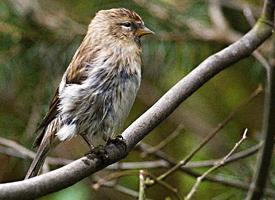
Greutăți și măsuri
| Lungime | 17 cm |
|---|---|
| Greutate | 94 g |
| Lungimea anvergurii aripilor | 28 cm |
Starea de conservare
| Amenințat |
Descrierea animalului
The Red Crossbill, scientifically known as Loxia curvirostra, is a distinctive and fascinating bird species belonging to the finch family, renowned for its unique bill morphology and intriguing feeding habits. This small to medium-sized bird possesses a remarkable adaptation that sets it apart from other avian species: its crossed mandibles. The peculiar structure of its bill, with the tips of the mandibles crossing over each other, is an evolutionary marvel, enabling the Red Crossbill to efficiently extract seeds from conifer cones, which constitute the primary component of its diet.Adult Red Crossbills exhibit sexual dimorphism in their plumage coloration. Males are characterized by a striking brick-red or orange coloration across their bodies, which serves as a vibrant signal during mating displays, whereas females display a more subdued olive-green or yellowish coloration, providing them with camouflage among the foliage. Juveniles tend to have a brownish or grayish plumage until they mature. This variation in plumage not only aids in individual identification but also plays a crucial role in their breeding and social behavior.
Measuring approximately 15 to 17 centimeters in length, with a wingspan ranging from 25 to 30 centimeters, Red Crossbills have a robust and somewhat stocky build. Their most notable feature, the cross-tipped bill, is not just a feeding tool but also a symbol of their specialization in exploiting the seeds of coniferous trees such as pines, spruces, and firs. The upper and lower mandibles, which cross at an angle, act like a pair of scissors, allowing the bird to snip open conifer cones and extract the seeds with remarkable dexterity.
The Red Crossbill is a nomadic species, often observed in flocks, and its movements are largely influenced by the availability of conifer seeds. Unlike many bird species that adhere to a strict migratory pattern, the Red Crossbill's movements are erratic, leading them to wander extensively in search of food sources. This nomadic lifestyle is crucial for their survival, especially in harsh winter conditions when food scarcity can pose a significant challenge.
Their vocalizations are complex and varied, including a series of trills and chirps that serve as communication signals among flock members. During the breeding season, males perform elaborate flight displays accompanied by melodious songs to attract mates. Interestingly, the Red Crossbill does not adhere to a fixed breeding season; instead, its reproductive timing is closely tied to the abundance of conifer seeds, leading to breeding behaviors that can occur at any time of the year when food resources are plentiful.
Nesting habits of the Red Crossbill are as unique as their feeding behaviors. They build their nests high in the conifer trees, using twigs, moss, and other plant materials to construct a secure platform for their eggs. The female typically lays 2 to 5 eggs per clutch, which she incubates for about two weeks until they hatch. Both parents are involved in feeding the chicks, which fledge approximately 18 to 22 days after hatching.
The Red Crossbill's specialized feeding adaptation has allowed it to thrive in coniferous forest habitats across the Northern Hemisphere, including North America, Europe, and Asia. However, like many wildlife species, it faces threats from habitat loss, climate change, and other environmental pressures that impact its food sources and breeding grounds.
In summary, the Red Crossbill is a remarkable bird, embodying the wonders of evolutionary adaptation. Its unique bill, vibrant plumage, nomadic lifestyle, and complex social behaviors make it a subject of fascination for birdwatchers and ornithologists alike. As a specialized feeder and a vital part of the ecosystem, the Red Crossbill highlights the intricate connections between species and their environments, underscoring the importance of conserving natural habitats for the continued survival of these and other remarkable avian species.
Animale similare
Fotografii noi cu animale
Top 10 animale
- Dolphin gull (Leucophaeus scoresbii)
- Diana monkey (Cercopithecus diana)
- Moustached guenon (Cercopithecus cephus)
- Stone loach (Barbatula barbatula)
- Greek tortoise (Testudo graeca)
- Galápagos tortoise (Geochelone nigra complex)
- Japanese macaque (Macaca fuscata)
- Russian tortoise (Testudo horsfieldii)
- Common flying dragon (Draco volans)
- Galápagos penguin (Spheniscus mendiculus)


